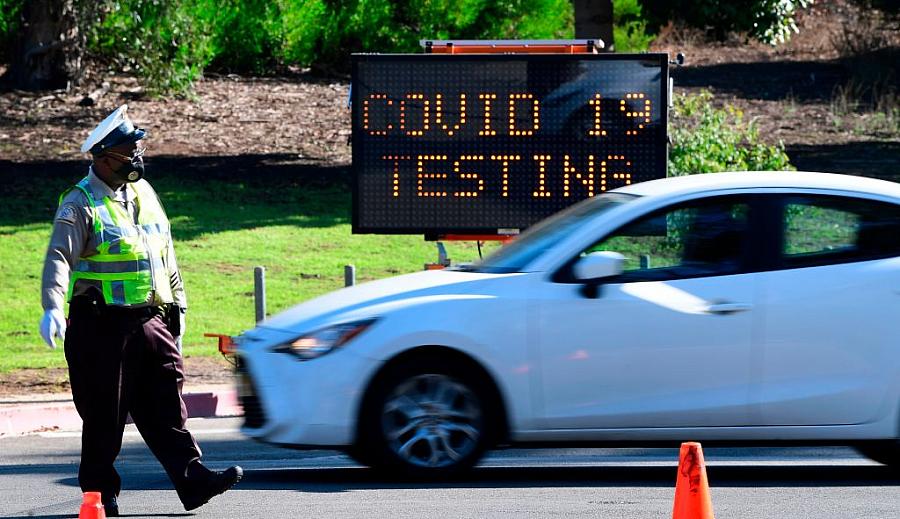Story idea: Compare your area to these counties after COVID-19 policy shifts

(Photo by Frederic J. Brown/AFP via Getty Images)
After weeks of living in lockdown, residents of Washington state were given some light at the end of the tunnel at the very end of May. Gov. Jay Inslee signed a proclamation spelling out his administration’s “Safe Start Washington” plan for a phased reopening after months of lockdown.
But we knew far less about COVID-19 and how it would behave back in May than we do now. The policy levers back then were blunt instruments by necessity: Keep everyone away from each other because we still weren’t sure how exactly this disease was being transmitted and what measures would actually work to change the trajectory of infections and deaths. So, it wasn’t surprising that people in Washington would start to push for the governor to revisit that proclamation. He made no motion on it prior to the election, but people in Washington expect that now the election is over things may change. Inslee, in effect, has a mandate to continue more of the same. He was reelected with more than 57% of the vote (2.2 million votes over his Republican opponent’s 1.7 million). That gives him the freedom to stay the course or to make some bold changes to policy without worrying about his reelection prospects.
Those kinds of internal calculations are happening all over the country at the state and even local level. And now is your chance to look closely at what happens over the next few weeks to see how public health policy in your area is affected by shifting political winds.
Remember: Just because the presidency has been won by a candidate who promises to follow the science related to COVID-19 does not mean that your local-level decision-makers will follow suit. In fact, the election results may have actually made some states and counties more inclined to make moves considered riskier from a health perspective while giving local communities the impression that they were returning to “normal” or regaining control of their lives.
Some states, like my home state of Montana, flipped their governorships from Democrat to Republican. Others flipped their Congressional representatives from Democrat to Republican. States saw Republican margins in state Legislatures increase in some places and decrease others.
In Oregon, for example, Gov. Kate Brown (D) waited until just after the election to make some moves that would not fly in Montana. Once her party’s control over the Legislature was secured in the election, giving her much needed backing in a state known for some volatile party politics, she issued new restrictions on counties where COVID-19 cases are on the rise. Those restrictions include, according to KGW8 News:
- Urging all businesses to mandate work from home to the greatest extent possible.
- Pausing long-term care facility visits to protect staff and residents.
- Reducing maximum restaurant capacity to 50 people (including customers and staff) for indoor dining, with a maximum party size of six. Continuing to encourage outdoor dining and take out.
- Reducing other indoor activity maximums capacity to 50 people (for example: gyms, fitness organizations/studios, bowling alleys, ice rinks, indoor sports, pools, museums).
- Limiting social gatherings to your household, or no more than 6 people if the gathering includes those from outside your household, reducing the frequency of those social gatherings (significantly in a two-week period), and keeping the same 6 people in your social gathering circle.
That’s a big list of restrictions. And it presents a chance for reporters to follow up in two weeks to see what has happened to cases in those counties. Then, you can compare those trends to what is happening in your own area.
Oregon’s new restrictions started on Nov. 11 and will run until Nov. 25 in five counties: Malheur, Marion, Multnomah, Jackson and Umatilla. While that is happening, you might put together a quick investigative piece that does three things:
1. Examine the number of confirmed cases, hospitalizations and deaths in the counties nowunder restrictions in Oregon.
2. Compares those trends to those in your counties of interest.
3. Contrasts the policies in Oregon to the policies in your own area.
4. Ask whether the policies explain the difference, or if some other variable jumps out.
In two-weeks' time, see how the trends in your location compare to the trends in those Oregon counties. Did your cases go up or down? How are deaths and hospitalizations trending?
Every time a policy shift happens in your area, you can look around for other areas in the same boat to see what they’re doing in response – especially if there are different political winds at play in the contrasting areas. It’s not exactly a controlled trial, in which the only differences are the policies in effect, but such an approach can give you an early sense of how different policies are leading to different outcomes during the rapidly worsening COVID-19 pandemic.
So far there has been no coherent national response to this pandemic, so you have the tough job of explaining to your audience what is working at a local by local level. It’s really all we have right now. We can wait and see if a more comprehensive approach at the federal level emerges in January.

